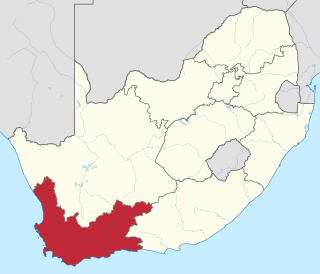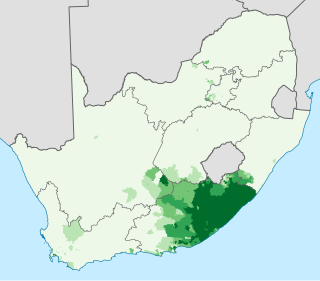In South Africa, manually coded language is used in education, as a bridge between South African Sign Language (SASL) and the eleven official oral languages of the country. These codes apply the signs of SASL to the grammar of the oral languages, resulting in Signed English , Signed Afrikaans, Signed Xhosa, Signed Zulu, etc. They are not a natural form of communication among deaf people.

South Africa, officially the Republic of South Africa (RSA), is the southernmost country in Africa. It is bounded to the south by 2,798 kilometres (1,739 mi) of coastline of Southern Africa stretching along the South Atlantic and Indian Oceans; to the north by the neighbouring countries of Namibia, Botswana, and Zimbabwe; and to the east and northeast by Mozambique and Eswatini (Swaziland); and it surrounds the enclaved country of Lesotho. South Africa is the largest country in Southern Africa and the 25th-largest country in the world by land area and, with over 57 million people, is the world's 24th-most populous nation. It is the southernmost country on the mainland of the Old World or the Eastern Hemisphere. About 80 percent of South Africans are of Bantu ancestry, divided among a variety of ethnic groups speaking different African languages, nine of which have official status. The remaining population consists of Africa's largest communities of European, Asian (Indian), and multiracial (Coloured) ancestry.
Manually coded languages are not themselves languages but are representations of oral languages in a gestural-visual form; that is, signed versions of oral languages. Unlike the sign languages that have evolved naturally in deaf communities, which have distinct spatial structures, these manual codes (MCL) are the conscious invention of deaf and hearing educators, and mostly follow the grammar of the oral language—or, more precisely, of the written form of the oral language. They have been mainly used in deaf education in an effort to "represent English on the hands" and by sign language interpreters in K-12 schools, although they have had some influence on deaf sign languages where their implementation was widespread.

South African Sign Language (SASL) is the primary sign language spoken by Deaf in South Africa. The South African government added a National Language Unit for South African Sign Language in 2001. SASL is not the only manual language spoken in South Africa, but it is the language that is being promoted as the language to be used by all Deaf in South Africa, although Deaf peoples in South Africa historically do not form a single group.
Manually coded language is commonly used instead of SASL for simultaneous translation from an oral language into sign, for example at the Deaf Forum that is held annually at different locations in the Western Cape. The result is that, while deaf people from different language communities can communicate with each other without difficulty in SASL, they cannot understand "sign language" interpreters unless they have been schooled in the particular manually coded language used by the interpreter. That is, while they share a common language in SASL, they differ in their understanding of Signed English, Signed Afrikaans, Signed Xhosa, etc., which are not a normal form of communication for anyone. This results is the common misconception among even deaf South Africans that there are various sign languages in the country, when in fact there is only one. [1]

The Western Cape is a province of South Africa, situated on the south-western coast of the country. It is the fourth largest of the nine provinces with an area of 129,449 square kilometres (49,981 sq mi), and the third most populous, with an estimated 6.6 million inhabitants in 2018. About two-thirds of these inhabitants live in the metropolitan area of Cape Town, which is also the provincial capital. The Western Cape was created in 1994 from part of the former Cape Province.
A very different form of manually coded language is cued speech, an aid to lipreading which has been developed for Afrikaans, South African English, and Setswana.
Cued Speech is a visual system of communication used with and among deaf or hard-of-hearing people. It is a phonemic-based system which makes traditionally spoken languages accessible by using a small number of handshapes, known as cues, in different locations near the mouth, as a supplement to speechreading. The National Cued Speech Association defines Cued Speech as "...a visual mode of communication that uses hand shapes and placements in combination with the mouth movements and speech to make the phonemes of spoken language look different from each other." It adds information about the phonology of the word that is not visible on the lips. This allows people with hearing or language difficulties to visually access the fundamental properties of language. It is now used with people with a variety of language, speech, communication, and learning needs. It is different from American Sign Language (ASL), which is a separate language from English. Cued Speech is considered a communication modality, but can be used as a strategy to support auditory rehabilitation, speech articulation, and literacy development.



